
by DharamCW | Apr 27, 2025 | Industry Trends and Insights, Leadership in Project Management
💡 Ever felt like you’re faking it, even while leading complex projects?
Impostor syndrome doesn’t spare even the most experienced managers—especially during high-stakes initiatives.
Here’s why:
🔹 MULTIFACETED ROLES INCREASE PRESSURE
High-stakes projects demand managers to juggle leadership, communication, and risk management roles, fostering self-doubt.
🔹 FAST-PACED, EVOLVING ENVIRONMENTS
Rapid changes in priorities and technologies amplify fears of falling behind.
🔹 PERFECTIONISM EXPECTATIONS
Striving for flawless execution leaves little room for error, fueling anxiety.
🔹 COMPLEX STAKEHOLDER DEMANDS
Balancing conflicting stakeholder needs often leads to second-guessing decisions.
🔹 CULTURAL AND GENDER DYNAMICS
Systemic biases and cultural expectations exacerbate self-doubt, especially for underrepresented groups.
💬 Which of these challenges resonate with you the most?
Let’s open up the conversation below.
View our upcoming PgMP® Programs
Online → http://bit.ly/2oBKQXQ
Direct → http://bit.ly/2oCfpg0
View our upcoming PfMP® Programs:
Online → http://bit.ly/39jOZSf
Direct → http://bit.ly/38er2M3
🎙️ Got questions about your Project Management career or PMI certifications?
Book your FREE 15-min session with me at 👉 www.talktodharam.com
📞 Contact Us
📱 Call: +1 650-283-0123
📧 Email: [email protected]
🎧 Subscribe & Stay Ahead
Webinars & Success Stories: https://bit.ly/2YF0wJl
Podcasts & Interviews: https://bit.ly/2NDY8wd
#PgMP #PfMP #ProgramManagement #PortfolioManagement #Leadership #ImpostorSyndrome #vCareProjectManagement #DharamSingh #PMICertifications #ProjectLeadership #WomenInLeadership #CareerGrowth #SelfDoubt #HighStakesProjects #MindsetMatters
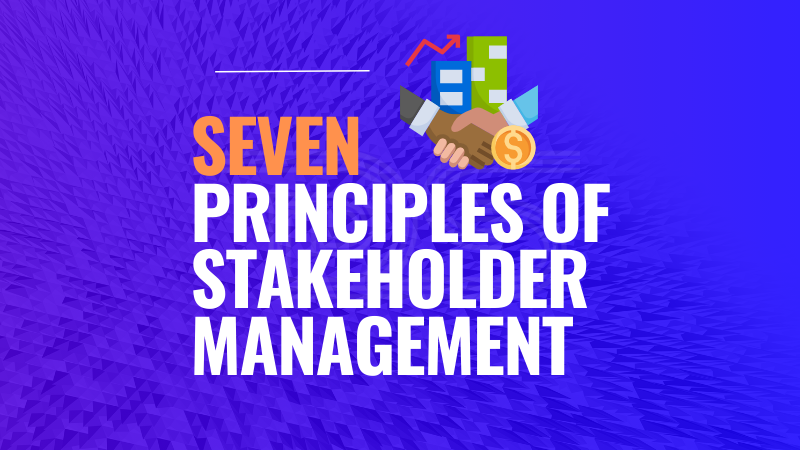
by DharamCW | Apr 10, 2025 | Uncategorized
🔑 Mastering Stakeholder Management: A Non-Negotiable for Program & Portfolio Success
Whether you’re managing a single project or steering an enterprise-wide transformation, your ability to influence and align stakeholders can make or break success.
I’ve distilled my learnings into 7 powerful principles of stakeholder management — essential for every Project, Program, and Portfolio Manager:
1️⃣ Identify Stakeholders – Recognize key individuals who impact or are impacted by your project.
2️⃣ Understand Their Needs – Assess stakeholder expectations, interests, and concerns for better alignment.
3️⃣ Maintain Transparency – Provide clear, honest, and timely communication to build trust.
4️⃣ Engage Proactively – Actively involve stakeholders to prevent misunderstandings and conflicts.
5️⃣ Manage Conflicts Respectfully – Address stakeholder concerns with diplomacy and mutual respect.
6️⃣ Align Interests and Goals – Find common ground to create win-win outcomes for all stakeholders.
7️⃣ Foster Long-Term Relationships – Strong stakeholder relationships drive continuous success and trust.
Each principle empowers you to build trust, mitigate resistance, and ensure strategic alignment at every level. 💼🌍
👉 Swipe through the carousel to dive deeper into each principle.
💬 Which of these principles do you apply consistently? Which one challenges you the most? Drop your thoughts below!
🔁 Save this post for your next stakeholder engagement planning session.
📌Need expert guidance? Book a free consultation -> http://talktodharam.com
Contact Us:
Call us: +1 650-283-0123 (U.S.)
Email: [email protected]
Subscribe for More:
Webinars & Success Stories https://bit.ly/2YF0wJl
Podcasts and Interviews: https://bit.ly/2NDY8wd
🔔 Follow me for more insights on PgMP, PfMP, and strategic leadership.
#StakeholderManagement #ProgramManagement #PortfolioManagement #PgMP #PfMP #Leadership #StrategyExecution #ProjectLeadership #vCareProjectManagement #DharamSingh #PMICertification #ChangeManagement #InfluenceLeadership
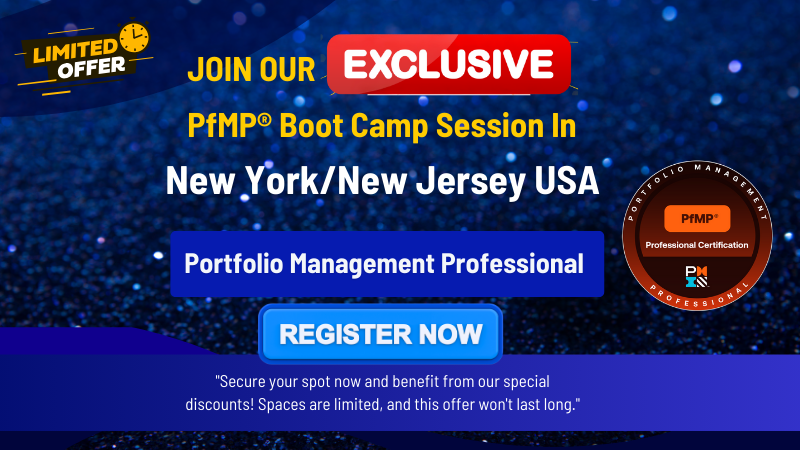
by DharamCW | Apr 8, 2025 | vCare PMI Certification Training Classes
🚀 Excited to Announce Our PfMP Bootcamp in New Jersey | United States
Join me from May 9th to 11th, 2025 for a 3-day intensive Portfolio Management Professional (PfMP)® Bootcamp designed to help you master the art of Portfolio Management and successfully clear the PfMP® certification.
📍 Location: New Jersey
🕘 Time: 9 AM to 5 PM (EDT)
👨🏫 Trainer: Dharam Singh – Leading PgMP® & PfMP® Mentor | vCare Project Management
Register Link -> https://bit.ly/3GL3LnO
💡 What You’ll Gain:
✅ PfMP® Complete Reference Guide
✅ Proven exam preparation tips & strategies
✅ PfMP® Pathfinder: Mapping ECO Tasks
✅ 48 PDUs / Contact Hours
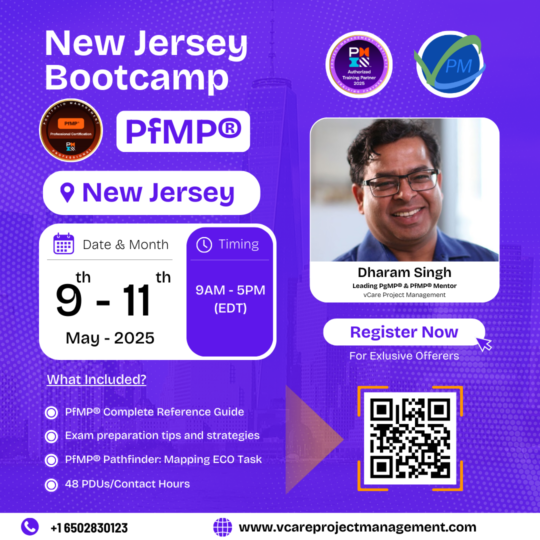
New Jersey PfMP Bootcamp – May 9 to 11, 2025 | Train with Dharam Singh and accelerate your portfolio career
🎯 Whether you’re aiming to elevate your portfolio leadership or earn your PfMP® credential, this session is tailored just for you!
📌 Explore Our PfMP® Programs:
🌐 Online Training → http://bit.ly/39jOZSf
🏛 Direct Training → http://bit.ly/38er2M3
📌 Join Our PfMP® Community:
PfMP4U LinkedIn Group → http://bit.ly/31P7GKR
📌 Essential PfMP® Study Materials:
PfMP Pathfinder – https://bit.ly/35j9Dli
The Complete Reference Guide for PfMP Certification – https://bit.ly/3pU4ud5
PfMP Challenger Mock Exam 1 | Exam Simulator – https://bit.ly/3KKZkv3
PfMP Challenger Mock Exam 2 | Exam Simulator – https://bit.ly/3VlI5FH
PfMP Challenger Mock Exam 3 | Exam Simulator – https://bit.ly/3VNrfRL
PfMP Challenger Gold (Mock Exams 1 to 3) | Exam Simulator – https://bit.ly/3KCjbNh
📲 Register Now for Exclusive Offers
👉 Scan the QR code or visit: www.vcareprojectmanagement.com
📞 Contact: +1 650 283 0123
#PfMP #PfMPCertification #PortfolioManagement #PMI #vCareProjectManagement #DharamSingh #NewJerseyBootcamp #PfMPBootcamp #PMISuccess #LeadershipDevelopment #PfMPMentor

by DharamCW | Mar 16, 2025 | PMI Certification Success Stories
🎉 Celebrating PfMP® Success: December 2024 – March 2025! 🌟
A huge congratulations to all professionals who achieved their Portfolio Management Professional (PfMP)® certification with the support of vCare Project Management! 🎯
🚀 We are thrilled to share that the global PfMP® community has now grown beyond 2,100+ certified professionals, with 167 new PfMP®s across 35 countries who trusted vCare’s expertise in their journey.
This milestone reflects the effectiveness of our structured training, mentorship, and exam preparation resources. We are proud to be part of your success and look forward to guiding more professionals towards portfolio management excellence.
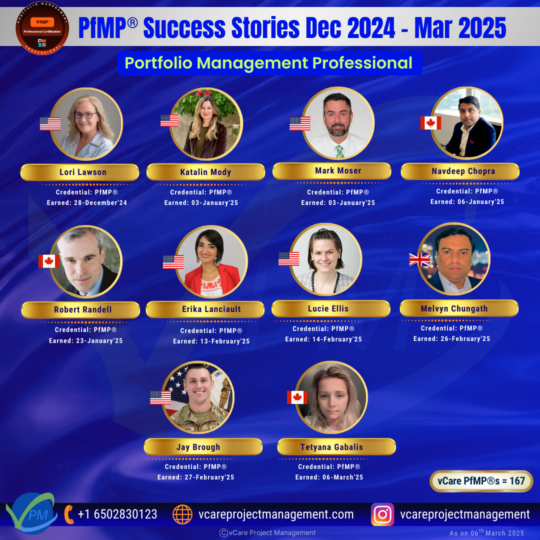
167 professionals earned their PfMP certification with vCare’s guidance! Join our training programs and advance your career.
🔹 Ready to elevate your portfolio management career?
Let’s make your PfMP® journey a success! DM me for guidance.
📌 Explore Our PfMP® Programs:
🌐 Online Training → http://bit.ly/39jOZSf
🏛 Direct Training → http://bit.ly/38er2M3
📌 Join Our PfMP® Community:
PfMP4U LinkedIn Group → http://bit.ly/31P7GKR
📌 Essential PfMP® Study Materials:
PfMP Pathfinder – https://bit.ly/35j9Dli
The Complete Reference Guide for PfMP Certification – https://bit.ly/3pU4ud5
PfMP Challenger Mock Exam 1 | Exam Simulator – https://bit.ly/3KKZkv3
PfMP Challenger Mock Exam 2 | Exam Simulator – https://bit.ly/3VlI5FH
PfMP Challenger Mock Exam 3 | Exam Simulator – https://bit.ly/3VNrfRL
PfMP Challenger Gold (Mock Exams 1 to 3) | Exam Simulator – https://bit.ly/3KCjbNh
📌 Upcoming Webinar:
🔹 Resilient Leadership in Cyber-Driven Programs with Dr. Maria Sette → https://bit.ly/4j9fmPA
📌Need expert guidance? Book a free consultation with me: http://talktodharam.com
🎥 Stay Updated with Project Management Insights!
🔔 Subscribe to vCare Project Management YouTube Channel: https://bit.ly/2YF0wJl
🎙 Follow My Podcasts & Expert Interviews: https://bit.ly/2NDY8wd
#PfMP #PortfolioManagement #PMICertification #vCarePfMP #CareerGrowth #SuccessStory #Leadership #ProjectManagement #GlobalCommunity #PfMPTraining #CertificationSuccess
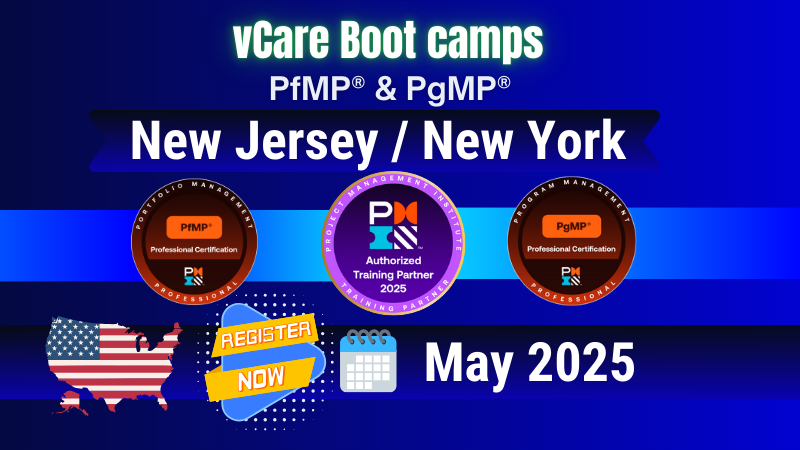
by DharamCW | Mar 13, 2025 | vCare PMI Certification Training Classes
🌟 US Project, Program & Portfolio Managers – This is Your Chance to Get Certified! 🌏
📢 Join me in New Jersey / New York this May 2025 for exclusive PfMP® & PgMP® Bootcamps!
For US professionals, vCare Project Management has consistently delivered exceptional certification success rates. 🚀
vCare Certification Success as of March 13, 2025:
✅ PgMP Certification in the US – 163 PgMPs mentored by vCare (Total vCare PgMPs: 541+)
✅ PfMP Certification in the US – 54 PfMPs mentored by vCare (Total vCare PfMPs: 167+)
🔥 Why Choose This Bootcamp?
✔ Proven Success – 541+ PgMPs & 167+ PfMPs certified globally
✔ Expert Coaching – Real-world insights from 30+ years of experience
✔ Focused Learning – Interactive, result-driven training
✔ Peer Networking – Connect with like-minded professionals
📍 Bootcamp Details – Limited Seats Available!
📍 Where? New Jersey / New York
📅 PgMP® Bootcamp: May 06 – 08, 2025 🔗 https://bit.ly/3NJoHNC
📅 PfMP® Bootcamp: May 09 – 11, 2025 🔗 https://bit.ly/3GL3LnO
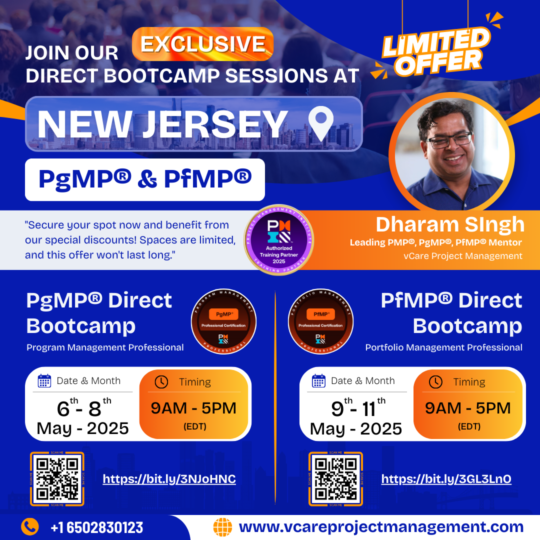
Advance your career with our PgMP & PfMP Bootcamps in New York/New Jersey – Limited seats available!
🚀 Exclusive Offers & Discounts on Training Programs!
👉 Check out special offers here: https://bit.ly/3jWVepD
🎯 Not Sure If You’re Ready? Let’s Talk!
💡 Book a FREE 15-min Consultation with Me: 🔗 http://www.talktodharam.com/
📺 Stay Ahead in Project Management!
🔔 Subscribe to vCare Project Management YouTube Channel: https://bit.ly/2YF0wJl
🎙 Follow My Podcasts & Expert Interviews: https://bit.ly/2NDY8wd
💬 Thinking about getting your PgMP or PfMP certification? Drop your questions in the comments, and let’s discuss how you can pass on your first attempt! 👇
#PgMP #PfMP #ProjectManagement #Bootcamp #NewJersey #NewYork #USBootcamp #CertificationSuccess #vCareProjectManagement #PortfolioManagement #ProgramManagement









Recent Comments